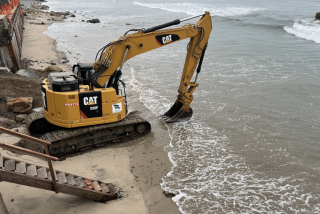Coastal Commission Orders Chevron to Restore Lost Waves : Environment: State panel says oil giant contributed to the loss of surfing habitat when it built a jetty into the waters near El Segundo refinery.
- Share via
The California Coastal Commission on Wednesday unanimously reaffirmed that Chevron Oil Company contributed to the loss of surfing habitat at a stretch of South Bay beach and must somehow restore the lost waves.
“If the Chevron project had not been there, surfing would have been there,” Commissioner David L. Malcolm said of a rock groin that the commission allowed Chevron to build in Santa Monica Bay next to its refinery in El Segundo in 1983.
Malcolm said that if wetlands and sea grass are lost when coastal tracts are developed, developers must replace them. Waves and good surfing are no different, he said.
In reaffirming the conditions of the original permit to build the groin, the commission sided with area surfers who have waged a decade-long battle to recapture the waves they lost when Chevron built the jetty-like projection into the bay to help protect the pipes that link the refinery to offshore terminals.
At the time it granted the Chevron permit, the commission said that if the groin changed wave patterns to the detriment of surfing, the oil firm would have to find a remedy.
A subsequent five-year study showed that, indeed, the natural sand bars on the ocean floor that are essential to the production of the tube-like swells surfers love to ride were wiped out after the groin was built.
After years of unproductive negotiations between Chevron and the surfers, represented by the Surfrider Foundation of Huntington Beach, an eco-surfer activist group, the commission staff came up with a recommendation.
Peter Douglas, executive director of the commission, said the staff had trouble determining exactly what Chevron should do to restore the beach.
Under terms of the proposed settlement, Chevron’s mitigation would have been a payment of up to $100,000 for a study to identify ideal surfing areas in the Southland, as well as actions that would endanger or enhance those beaches.
The coastal commissioners, however, agreed with surfers that a study did not represent true mitigation. Commissioner Jane Yokoyama said the staff’s suggestion was like being hit by a car and then having the driver say, “I’m going to give you this book that (lists) the best cars to get hit by.”
The surfers want Chevron to pay for an artificial reef made of massive sandbags, which the Surfrider Foundation estimates would cost about $350,000. According to technical experts the foundation has hired, the reef would take the place of the natural sand bars that have been lost. They said the reef would produce the kind of waves necessary for surfing.
Surfers who spoke at the meeting made it clear they do not need a study.
“We have all the literature on surfing we need,” said Terry McCann, a member of the foundation’s board of directors.
Tim Dion, who said he grew up in El Segundo and now owns a surf shop in Malibu, told the commission that he used to surf the beach at the end of Grand Avenue from 1973 to 1981. Since the groin was built, he said, “That whole stretch of beach is dead to the surfers.”
Rod Spackman, a Chevron spokesman, told the commission that many changes have taken place at the beach, not all of them due to Chevron. He noted that the Hyperion Sewer Treatment plant in Playa del Rey, which is owned by Los Angeles, brought in sand to help broaden the beach.
In addition, Spackman said, Chevron built the groin to restore the beach after it was washed away in a storm. Today, he said, the company pays for lifeguards there and has built a bike path along the stretch of sand.
“We want some reasonable recognition of what we’ve already contributed,” a disappointed Spackman said after the commission vote.
Commissioners said they want their staff to work with Chevron and the surfers to formulate suggestions for restoring surfing to the area. The staff is expected to report back to the commission by October, said Thomas Pratte, a consultant hired by the Surfrider Foundation.
More to Read
Sign up for Essential California
The most important California stories and recommendations in your inbox every morning.
You may occasionally receive promotional content from the Los Angeles Times.










